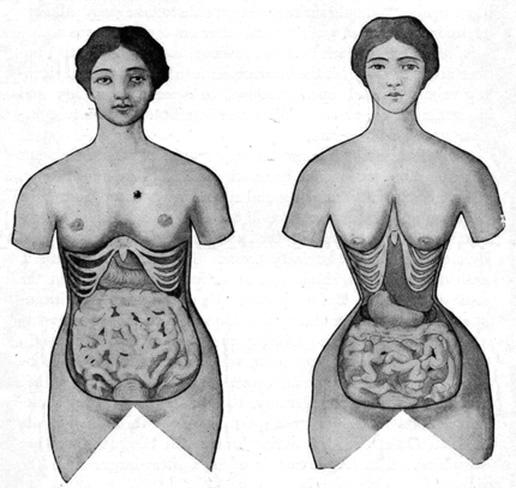Waist training brings back a Victorian-era fad

The young adolescent girl’s already pale knuckles turn white as she wraps her fingers around the corner of her wardrobe, bracing herself. Her nurse, a large woman with a stern face, mercilessly yanks the ribbons of the girls’ corset. Again and again. Tighter and tighter. You watch the scene on your television from the comforts of your overstuffed couch with your mouth open, letting the handful of popcorn in your palm topple back into the bowl. With each tug of the string you watch the girl’s breath escape her; you find yourself instinctively gasping along with her. You wince as the scene cuts to a close up of the girls’ knuckles again. Her palms are sweaty and the wardrobe she holds onto shakes with each violent heave from her nurse. When the scene is over you finally let out a sigh of relief and continue on to your popcorn, relieved that the uncomfortable spectacle is finally over; meanwhile, the young adolescent girl on the television struggles to take a deep breath.
Corsets were once very common during the mid-nineteenth century and into the early twentieth century; however, controversy over them quickly resulting in the fashion statement being reduced to nothing more than a ludicrous “Victorian-Era Fad.” Modern girls would scoff at whoever thought of the garment, and Hollywood would only adopt it for authentic costume design in films. However, a new trend in today’s fashion has brought back this “fad,” along with its controversies.
Recently, corsets have become a popular consumer item because of a new trend called “waist training,” or “waist slimming.” The act consists of an individual using corsets to slowly – over a period of several weeks/months – alter the shape of their waist. The corsets used today differ from those used in the nineteenth century. Today, corsets are not generally pulled tight by another person. Instead, they either adapt a seamless design, similar to spandex, or they have clasps on them, similar to bras. Corsets differ from spandex, which are typically used to give someone a slimmer appearance quickly, for a short period of time, whereas waist-training uses corsets to permanently alter an individual’s body by gradually thinning their waistline over time. Companies selling corsets today claim that their products not only offer the immediate illusion of a thinner silhouette, like with spandex, but it can result in a semi-permanent to permanent difference in their waist size, and many consumers are openly advocating for this body modification process.
A large reason this trend has become so popular is because of celebrities who have been promoting the new fad. Kim Kardashian is one of the most recognized celebrity campaigners, and is largely responsible for waist-training’s newfound popularity after she posted a photo on a social media account of herself posing while wearing a corset. She captioned the picture saying she actively participates in waist-training and loves the corset she has. Kim’s sister, Khloe Kardashian, is also a strong supporter of the movement, and movie star Jessica Alba has stated in interviews that waist-training has helped her achieve her pre-baby body, post-baby.
Many individuals look up to celebrities and wish to be like them in various ways, including in appearance. Celebrities are portrayed as being the most attractive people in our society, and many assume their beauty is key to their success. This causes some people to go to drastic lengths to achieve the type of look that Hollywood and mainstream media has dubbed “beautiful.” Whether or not celebrities outright tell people to buy corsets or participate in waist-training, their public approval of the body modification process has sparked a sudden mainstream popularity among young adults. More young adults are trying waist-training to see if it really works, or to try and achieve the “perfect hourglass” figure it guarantees to produce. Due to the growing popularity, waist-training is now becoming its own culture with its own community of individuals. Entire websites are dedicated to the topic of waist-training, offering beginner tips, success stories, and links to purchase corsets. These links may even bring someone to large retail stores, such as Walmart.
However, with all of this success, waist-training has also witnessed its fair share of criticism. Various doctors have gone on record to publically condemn the practice, and to warn others from pursuing it. One of the major concerns with corsets is that they constrict the upper respiratory area, resulting in difficulty breathing. It was believed that back in the nineteenth century corsets resulted in various cases of fainting spells and difficulty breathing, which lead to the general widespread belief that corsets were bad. However, most of the assumed dangerous effects of corsets have been disproven, or can supposedly be prevented with proper waist-training techniques.
Waist-training typically becomes dangerous when the individual tries to rush their results, damaging their organs. So far, participants who follow a slow and deliberate training schedule have not experienced significant differences in their health for it to be linked to the waist-training; the only difference they reported was a shift in the placement of their organs, and a smaller waistline. Though the organs may shift, some doctors say that’s fine, and the organs themselves are not damaged. It’s unclear what the results are on individuals who take waist-training to extreme lengths, manipulating their body into unnatural measurements inspired by cartoon characters, such as Jessica Rabbit.
Recently, Lily James, the star of the new live-action Cinderella movie, told reporters she wore a corset during much of the filming process, resulting in a mild alteration of her waist. The actress argued that she didn’t partake in any unhealthy weight loss regimen, and that the slight alteration in her figure was done gradually and unintentionally; she also stated that the corset was only for the use of the film, and did not imply that she partakes in waist-training. Though James has brushed off the use of the corset as being no big deal, her thin waistline has been up for scrutiny. Until James snuffed out the rumor in an interview, many believed her tiny waist in the Cinderella film was the result of a computer generated image. In other words, people believed James’ waist was photoshopped to look smaller. This resulted in an uproar within the social media as individuals around the world offered their opinion on James’ small waist. Some argued she was too thin to be healthy, and others assumed Hollywood was seizing another opportunity to lower young adults’ self-esteem by setting unrealistic beauty standards.
Corsets were prominent for almost a century and have now made a comeback, yet despite this and the widening acceptance of body modification, society continues to have conflicting views regarding corsets and waist-training. Historical evidence implies the dangers of corsets, but modern anecdotes disprove that – and some doctors warn every one of the life-threatening ramifications while other doctors state that although they recommend a healthy diet over waist-training, they haven’t found any evidence to suggest it is unsafe.
Right now there simply isn’t enough evidence to support or disprove either argument, yet despite the lack of research and knowledge surrounding the topic, people still risk the dangers in hopes of achieving their desired figure.
This type of figure – where ones’ proportions are exaggerated – has become more desired as celebrities like Beyonce Knowles and Kim Kardashian are overtly praised for their curvaceous bodies, granting them the label of “real women.” But, the corset industry hasn’t just stopped at helping produce “real women” bodies. Many companies have expanded their market to include men. More corsets are being introduced into the market that are targeted specifically for the bodies of men.
Between celebrity advocates, inconclusive medical evidence regarding dangers, and broadened targeted consumers, corsets are no longer a thing of the past. More products are being introduced so the average consumer can alter their appearance and feel and look beautiful without going under the knife. It is implied that anyone can achieve Kim Kardashian’s look without shelling out thousands of dollars for a gym membership or surgery, instead they can simply order a corset online. It’s not only an immediate slimmer, but it gradually thins their waist over time, with little-to-no effort from the consumer – and our generation is all about easy results.
For now, only time (and research) can tell whether or not the use of corsets, and the practice of waist-training is dangerous to ones’ health, and whether or not the trend will outlast its previous “century of fame” or, if as before, it will fizzle out into fashion history. However, what seems to be apparent is that regardless of the future of corsets, our society gravitates towards new popular trends regardless of possible health risks and notable controversies.





